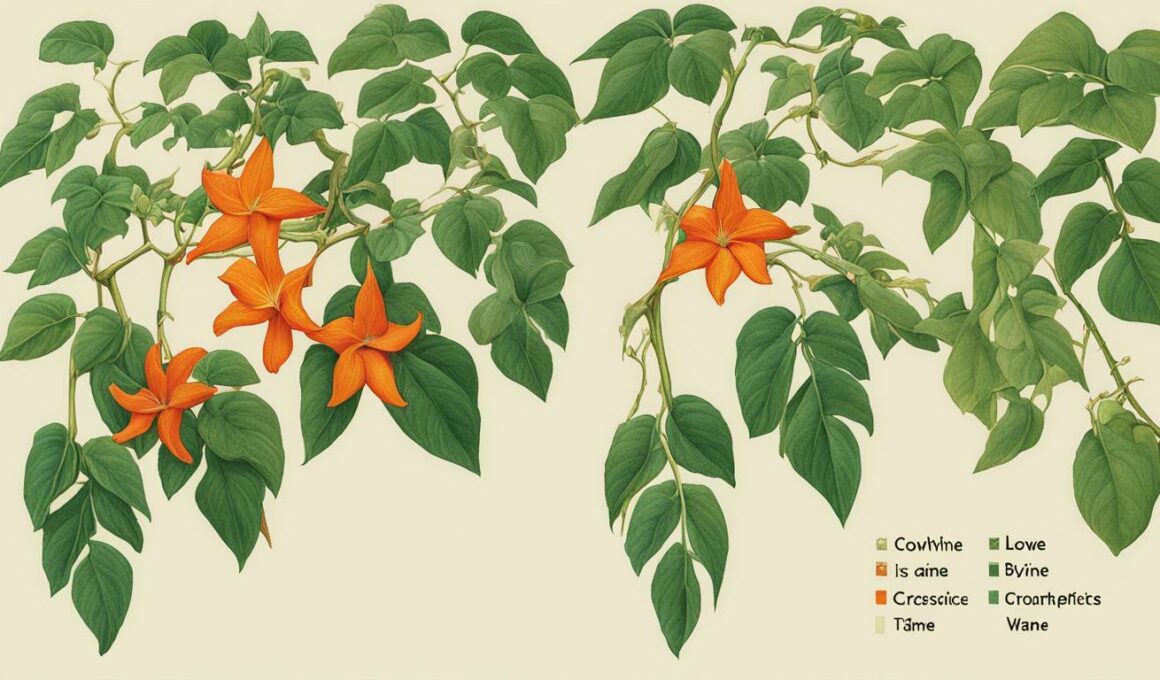If you’re a gardening enthusiast, then you’re probably familiar with the trumpet-shaped flowers of vines. Two popular choices are crossvine and trumpet vine, but are they the same thing? At first glance, they may look familiar, but there are some differences that set them apart. In this article, we’ll explore the similarities and differences between crossvine and trumpet vine, helping you make an informed decision about which vine will work best for your garden.
Post Summary:- Crossvine and trumpet vine are not the same plant, but they share some similarities.
- Crossvine and trumpet vine have different growth habits, flower colors, and foliage.
- Both vines are easy to grow and maintain, and can add beauty and charm to any garden.
Differences Between Crossvine and Trumpet Vine
If you’re looking for a climbing plant to add to your garden, you may be wondering about the differences between crossvine and trumpet vine. While both of these plants are known for their ability to climb, there are several key differences that set them apart.
| Aspect | Crossvine | Trumpet Vine |
|---|---|---|
| Appearance | Crossvine has dark green, glossy leaves and trumpet-shaped flowers that can be red, orange, or yellow. | Trumpet vine has pinnate leaves and trumpet-shaped flowers that are usually orange or red. |
| Growth Habits | Crossvine grows at a moderate pace and can reach heights of up to 50 feet. It can also spread up to 30 feet wide. | Trumpet vine is known for its rapid growth and can easily reach heights of 30 feet or more. It can also spread aggressively and may require regular pruning to keep it in check. |
| Preferred Growing Conditions | Crossvine prefers full sun to partial shade and well-drained soil. It can tolerate drought conditions once established. | Trumpet vine prefers full sun and moist, well-drained soil. It can tolerate some shade, but may not flower as prolifically. |
Overall, crossvine and trumpet vine have distinct differences in appearance, growth habits, and preferred growing conditions. When selecting a vine for your garden, it is important to consider these factors and choose the one that best fits your needs and preferences.
Similarities Between Crossvine and Trumpet Vine
If you’re trying to decide between planting crossvine or trumpet vine, you might be interested in knowing some of the similarities they share:
- Trumpet-shaped flowers: Both crossvine and trumpet vine produce flowers shaped like trumpets that can attract hummingbirds, bees, and other pollinators to your garden.
- Ability to climb: Both vines have aerial roots or tendrils that can cling to walls, trellises, and other supports, allowing them to climb vertically and create a lush, green wall of foliage and flowers.
- Fast growth: Crossvine and trumpet vine are considered fast-growing plants, achieving a mature size within a few seasons of growth.
- Low maintenance: Once established, both vines can tolerate a range of soil types and conditions and require little maintenance beyond pruning and training to keep them tidy.
While there are some significant differences between crossvine and trumpet vine, it’s important to recognize that they also have many similarities that make them both attractive options for gardeners looking to add some vertical interest to their landscape.
Are Honeybees Attracted to Crossvine in the Same Way as Trumpet Vine?
Crossvine and trumpet vine are both attractive to honeybees. The honeybees and trumpet vine connection is strong, as these buzzing insects are drawn to the vibrant colors and sweet nectar produced by both plants. Crossvine’s trumpet-shaped flowers and trumpet vine’s long, tubular blooms make them irresistible to honeybees seeking pollen and nectar sources. These plants play an important role in supporting our buzzing friends and promoting pollination.
Crossvine vs. Trumpet Vine: A Comparison
Both crossvine and trumpet vine are popular climbing plants that can add visual interest and vertical dimension to your garden or outdoor space. However, they have distinct differences that may make one more suitable for your needs than the other.
When it comes to growth rate, trumpet vine tends to grow faster and more aggressively than crossvine, often reaching lengths of up to 30 feet in a single season. On the other hand, crossvine tends to grow more slowly and can take several years to reach its full potential.
The flowers of these two plants are also different in color and shape. Trumpet vine flowers are usually bright orange or red with a trumpet shape, while crossvine flowers come in shades of red, orange, yellow, and pink and have a flared shape.
Another difference between crossvine and trumpet vine is their foliage. Crossvine has glossy, evergreen leaves that provide year-round coverage, while trumpet vine leaves are deciduous and drop in the fall.
In terms of maintenance, crossvine is generally considered to be easier to care for than trumpet vine. Crossvine requires less water and fertilizer, and is less prone to disease and insect infestations. Trumpet vine, on the other hand, can be more susceptible to pest issues and may require more frequent pruning to keep it under control.
| Crossvine | Trumpet Vine | |
|---|---|---|
| Growth Rate | Slow | Fast and aggressive |
| Flower Color and Shape | Red, orange, yellow, pink; flared | Bright orange or red; trumpet-shaped |
| Foliage | Glossy, evergreen | Deciduous, drops in fall |
| Maintenance | Easier to care for; requires less water and fertilizer, less prone to disease and infestations | May require more frequent pruning, (more) susceptible to pest issues |
Ultimately, the choice between crossvine and trumpet vine comes down to personal preference and the specific needs of your garden or outdoor space. Consider factors such as growth rate, flower color and shape, foliage, and maintenance requirements when making your decision.
Both of these vines can be a beautiful addition to your landscape, providing vertical interest, color, and texture. Choose the one that best fits your needs and enjoy the beauty it brings to your outdoor environment.
Conclusion
In conclusion, while crossvine and trumpet vine share some similarities, they are ultimately different plants. Crossvine has a slower growth rate, prefers partial shade, and produces unique red and yellow flowers. Trumpet vine grows quickly in full sun and produces orange or yellow trumpet-shaped flowers.
So, is crossvine the same as trumpet vine? No, they are not the same, but they both have their own unique features that make them great additions to any garden or landscape.
When deciding which vine to plant, consider your personal preferences and the growing conditions of your area. Both plants can be beautiful and low-maintenance additions to your outdoor space, as long as they are well-suited for their environment.
Whichever vine you choose, make sure to provide proper care and maintenance to ensure the health and longevity of your plant. With a little love, your crossvine or trumpet vine will thrive and provide beauty for years to come.
Is Crossvine as Fast-Growing as Trumpet Vine?
Many gardeners want to discover trumpet vine growth speed in comparison to crossvine. Crossvine is known for its rapid growth, but trumpet vine can grow even faster. With the right conditions, trumpet vine can reach remarkable heights in a short amount of time, making it a popular choice for quick coverage in gardens.
FAQ
Q: Is Crossvine The Same As Trumpet Vine?
A: No, crossvine is not the same as trumpet vine. While they are both climbing vines with trumpet-shaped flowers, they have distinct differences in appearance, growth habits, and preferred growing conditions.
Q: What are the differences between crossvine and trumpet vine?
A: Crossvine and trumpet vine have several key differences. Crossvine has glossy, leathery leaves and a more restricted growth habit, making it ideal for smaller spaces. Trumpet vine, on the other hand, has larger, serrated leaves and a vigorous growth habit that requires ample space. Additionally, crossvine prefers partial shade to full sun, while trumpet vine thrives in full sun.
Q: What are the similarities between crossvine and trumpet vine?
A: Crossvine and trumpet vine share some similarities. Both vines are capable of climbing and can be trained to grow on trellises, walls, or fences. They also produce trumpet-shaped flowers that attract hummingbirds and butterflies, adding beauty and wildlife to the garden.
Q: How do crossvine and trumpet vine compare?
A: When comparing crossvine and trumpet vine, there are several factors to consider. Crossvine tends to have a slower growth rate and is available in a variety of flower colors, including orange, red, and yellow. Trumpet vine, on the other hand, grows quickly and typically produces orange or red flowers. In terms of foliage, crossvine has glossy, evergreen leaves, while trumpet vine has larger, deciduous leaves. Maintenance requirements may also differ, with crossvine generally needing less pruning and maintenance.
Q: Conclusion
A: In conclusion, while crossvine and trumpet vine have some similarities, they are not the same plant. Crossvine offers a more compact growth habit and a wider range of flower colors, making it suitable for smaller spaces and diverse garden designs. On the other hand, trumpet vine is a vigorous grower with striking orange or red flowers, ideal for larger spaces where its rapid growth can be controlled. Choose the vine that best suits your preferences and gardening goals.









